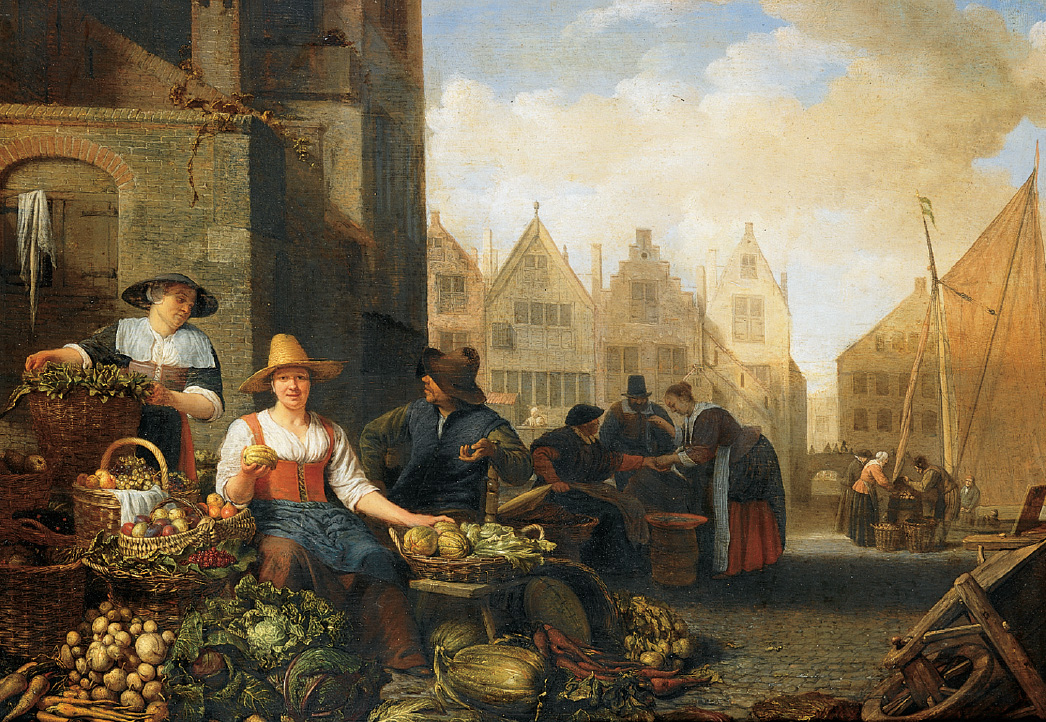A History of Western Society: Printed Page 543
A History of Western Society, Value Edition: Printed Page 554
The Leadership of the Low Countries and England
The seventeenth-century Dutch Republic, already the most advanced country in Europe in many areas of human endeavor, pioneered advancements in agriculture. By the middle of the seventeenth century intensive farming was well established, and the innovations of enclosed fields, continuous rotation, heavy manuring, and a wide variety of crops were all present. Agriculture was highly specialized and commercialized, especially in the province of Holland.
One reason for early Dutch leadership in farming was that the area was one of the most densely populated in Europe. In order to feed themselves and provide employment, the Dutch were forced at an early date to seek maximum yields from their land and to increase the cultivated area through the steady draining of marshes and swamps. The pressure of population was connected with the second cause: the growth of towns and cities. Stimulated by commerce and overseas trade, Amsterdam grew from thirty thousand to two hundred thousand inhabitants in its golden seventeenth century. The growing urban population provided Dutch peasants with markets for all they could produce and allowed each region to specialize in what it did best. Thus the Dutch could develop their potential, and the Low Countries became, as one historian wrote, “the Mecca of foreign agricultural experts who came … to see Flemish agriculture with their own eyes, to write about it and to propagate its methods in their home lands.”1
The English were among their best students. In the mid-seventeenth century English farmers borrowed the system of continuous crop rotation from the Dutch. They also drew on Dutch expertise in drainage and water control. Large parts of seventeenth-century Holland had once been sea and sea marsh, and the efforts of centuries had made the Dutch the world’s leaders in drainage. In the first half of the seventeenth century, Dutch experts made a great contribution to draining the extensive marshes, or fens, of wet and rainy England. The most famous of these Dutch engineers, Cornelius Vermuyden, directed one large drainage project in Yorkshire and another in Cambridgeshire. In the Cambridge fens, Vermuyden and his Dutch workers eventually reclaimed forty thousand acres, which were then farmed intensively in the Dutch manner. Swampy wilderness was converted into thousands of acres of some of the best land in England.
Based on the seventeenth-century achievements, English agriculture continued to progress during the eighteenth century, growing enough food to satisfy a rapidly growing population. Jethro Tull (1674–1741), part crank and part genius, was an important English innovator. A true son of the early Enlightenment, Tull adopted a critical attitude toward accepted ideas about farming and tried to develop better methods through empirical research. He was especially enthusiastic about using horses, rather than slower-moving oxen, for plowing. He also advocated sowing seed with drilling equipment rather than scattering it by hand. Drilling distributed seed in an even manner and at the proper depth. There were also improvements in livestock, inspired in part by the earlier successes of English country gentlemen in breeding ever-faster horses for the races and fox hunts that were their passions. Selective breeding of ordinary livestock was a marked improvement over the haphazard breeding of the past.

One of the most important — and bitterly contested — aspects of agricultural development was the enclosure of open fields and commons. More than half the farmland in England was enclosed through private initiatives prior to 1700; Parliament completed this work in the eighteenth century. From the 1760s to 1815 a series of acts of Parliament enclosed most of the remaining common land. Arthur Young, another agricultural experimentalist, celebrated large-scale enclosure as a necessary means to achieve progress. (See “Primary Source 17.1: Arthur Young on the Benefits of Enclosure.”) Many of his contemporaries, as well as the historians that followed him, echoed that conviction. More recent research, however, has shown that regions that maintained open-field farming were still able to adopt crop rotation and other innovations, suggesting that enclosures were not a prerequisite for increased production.
Many critics of Arthur Young’s day emphasized the social upheaval caused by enclosure. By eliminating common rights and greatly reducing the access of poor men and women to the land, the eighteenth-century enclosure movement marked the completion of two major historical developments in England — the rise of market-oriented estate agriculture and the emergence of a landless rural proletariat. By the early nineteenth century a tiny minority of wealthy English and Scottish landowners held most of the land and pursued profits aggressively, leasing their holdings through agents at competitive prices to middle-size farmers, who relied on landless laborers for their workforce. These landless laborers worked very long hours, usually following a dawn-to-dusk schedule six days a week all year long. Not only was the small landholder deprived of his land, but improvements in technology meant that fewer laborers were needed to work the large farms, and unemployment spread throughout the countryside. As one observer commented:
It is no uncommon thing for four or five wealthy graziers to engross a large inclosed lordship, which was before in the hands of twenty or thirty farmers, and as many smaller tenants or proprietors. All these are thereby thrown out of their livings, and many other families, who were chiefly employed and supported by them, such as blacksmiths, carpenters, wheelwrights and other artificers and tradesmen, besides their own labourers and servants.2
In no other European country had this proletarianization — this transformation of large numbers of small peasant farmers into landless rural wage earners — gone so far. England’s village poor found the cost of change heavy and unjust.